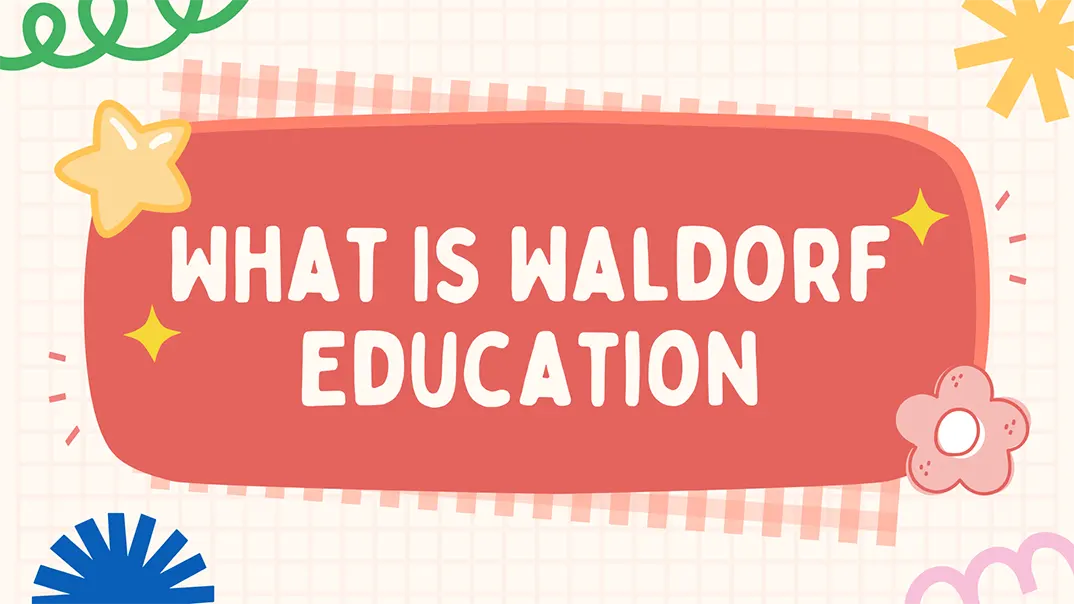In recent years, Waldorf education has received growing attention from parents, educators, and early childhood professionals. Known for its gentle, play-based approach and focus on nurturing the whole child, it stands out in today’s fast-paced educational landscape. Yet many people still don’t fully understand what Waldorf education truly involves. What are its guiding principles, and how does it support healthy development in the early years?
Waldorf education is a holistic and child-centered approach developed by Rudolf Steiner in the early 20th century. It focuses on nurturing a child’s imagination, creativity, and social responsibility through play-based and arts-integrated learning. Unlike conventional systems, Waldorf education places equal emphasis on emotional, physical, and intellectual development, making it a unique model in early childhood education.
As more kindergartens and preschools explore educational models beyond mainstream curricula, understanding what makes Waldorf education distinctive can help you make better decisions for your school or children. Let’s dive into how this method works and why it might be the perfect fit for your learning environment.
What Is the Waldorf Education Method?
The Waldorf education method is a holistic, developmentally appropriate approach to learning that emphasizes imagination, creativity, and experiential learning. Developed by Austrian philosopher Rudolf Steiner in 1919, this method views education as a process that should unfold in harmony with a child’s natural stages of growth—focusing not just on intellectual achievement, but also on emotional, physical, and spiritual development.
At its core, the Waldorf education method seeks to educate the “head, heart, and hands.” This means balancing academic instruction (head), social and emotional growth (heart), and practical, physical activities (hands). In the early childhood years, formal academics are intentionally delayed to allow children time to explore through play, rhythm, movement, and sensory experiences. Learning is not rushed; instead, children are encouraged to develop at their own pace in a nurturing and aesthetically beautiful environment.
Rather than relying on textbooks and testing, the Waldorf method uses storytelling, nature exploration, music, painting, handcrafts, and imaginative play as key teaching tools. Teachers often stay with the same group of children for several years, building deep relationships and offering consistent guidance. The classroom itself is considered a “living environment,” carefully designed to inspire calmness, wonder, and a sense of security.
Origins and History of Waldorf Education
The Waldorf education movement began in 1919 in Stuttgart, Germany, when Austrian philosopher and social reformer Rudolf Steiner was invited to create a school for the children of workers at the Waldorf-Astoria cigarette factory. This school—founded on Steiner’s spiritual-scientific worldview known as anthroposophy—marked the beginning of what is now known as Waldorf education.

Steiner’s vision was to cultivate not only intellectual abilities but also emotional strength, artistic sensibility, and moral character. He believed that education should be aligned with the natural stages of human development and that children should be taught in ways that respect their physical, emotional, and spiritual growth. His ideas quickly gained attention across Europe, and by the mid-20th century, Waldorf schools had begun to emerge in other countries.
Throughout the 20th century, the Waldorf approach continued to expand internationally. In the 1940s and 1950s, schools were established in the United States, the United Kingdom, and Australia. Despite facing challenges—especially under totalitarian regimes in Nazi Germany and the Soviet Union, where Waldorf schools were temporarily closed—the movement persisted and grew stronger in the postwar years.
Today, Waldorf education has become one of the largest independent school movements in the world. There are more than 1,100 Waldorf schools and nearly 2,000 Waldorf early childhood programs across over 70 countries. Although each school adapts to its cultural context, all share the same foundational principles: a respect for the developmental stages of the child, a commitment to the arts and practical work, and a belief in education as a path to personal and social renewal.
The historical roots of Waldorf education continue to shape its philosophy today, offering a time-tested, human-centered alternative to conventional education systems.
Waldorf Education Pros and Cons
While many parents and educators are drawn to the holistic and nurturing nature of Waldorf education, it’s important to understand both the strengths and challenges of this educational approach. Like any model, Waldorf education isn’t one-size-fits-all, and evaluating its pros and cons can help determine if it’s the right fit for children or aulas preescolares.

Advantages of Waldorf Education
Choosing the right educational path for a child is no small decision. For parents, teachers, and communities seeking a more holistic, nurturing, and thoughtful approach to learning, Waldorf education offers a wealth of unique advantages that set it apart from conventional models.
- Developmentally Appropriate Curriculum
One of the most recognized benefits of Waldorf education is its alignment with child development. The curriculum is designed to meet children where they are emotionally, cognitively, and physically. During early childhood, play-based learning, storytelling, and artistic expression replace traditional academic pressures. This gradual progression supports natural brain development and fosters genuine intellectual curiosity. - Cultivation of Imagination and Creativity
In a world that increasingly values innovation and problem-solving, Waldorf education stands out for its emphasis on the arts, creativity, and free expression. Every day is filled with painting, music, drama, handwork, and movement. These experiences not only enrich the child’s imagination but also enhance critical thinking and emotional intelligence. - Strong Teacher-Student Relationships
Teachers in Waldorf education often stay with the same group of students for several years, creating deep bonds and a secure learning environment. This continuity allows educators to develop a thorough understanding of each child’s strengths, challenges, and evolving needs, promoting personalized and empathetic instruction. - Minimal Use of Technology
In early Waldorf education settings, digital devices are intentionally avoided. Instead of screens, children interact with the world through hands-on experiences, face-to-face communication, and natural materials. This approach fosters real-world skills, deeper social connections, and enhanced sensory development. - Emphasis on Moral and Social Responsibility
Waldorf education goes beyond academic achievement—it aims to nurture compassionate, thoughtful, and responsible individuals. Through community involvement, seasonal festivals, and storytelling with moral themes, children learn empathy, cooperation, and respect for others. - Holistic Learning Experience
Rather than isolating subjects, Waldorf education integrates academic disciplines through storytelling, artistic interpretation, and thematic lessons. This interwoven approach makes learning meaningful and memorable, encouraging students to see connections between concepts and the real world. - Stress Reduction and Emotional Well-Being
With its slower pace, balanced daily rhythm, and absence of standardized testing, Waldorf education helps reduce anxiety and supports mental well-being. Classrooms are peaceful, aesthetically pleasing, and designed to encourage calm, focused learning. - Enhanced Focus and Attention Span
The avoidance of early exposure to overstimulating technology, combined with rhythmic routines and structured transitions, helps children in Waldorf education develop sustained attention and self-regulation skills—both of which are essential for lifelong success. - Individualized Learning Journey
Rather than pushing every child through the same academic milestones at the same pace, Waldorf education allows for flexibility. Teachers adapt lessons to each student’s needs, ensuring that no child feels rushed or left behind.
Potential Disadvantages and Criticisms of Waldorf Education
While Waldorf education offers many unique benefits, it is not without its challenges and criticisms. Understanding these concerns is essential for families and educators considering whether this approach aligns with their educational goals and expectations.
- Delayed Introduction to Academics
One of the most debated aspects of Waldorf education is the intentional delay of formal academics, especially reading and writing, until around age seven. Supporters argue this respects developmental readiness, but critics worry that it may leave children behind in traditional academic benchmarks or make transitions to mainstream schools more difficult. - Limited Exposure to Technology
Although many parents value the screen-free environment of Waldorf schools, others feel that a complete avoidance of digital tools may leave children underprepared for a technology-driven world. In an era where digital literacy is increasingly important, some see the Waldorf stance as overly idealistic or outdated. - Teacher-Centered Curriculum Design
Waldorf teachers often have significant autonomy in delivering content, and the curriculum is less standardized than in public or Montessori systems. While this allows for flexibility, it also raises concerns about consistency, especially when teachers vary in training or interpretation of Steiner’s philosophy. - Philosophical and Spiritual Foundations
Waldorf education is rooted in the anthroposophical worldview of Rudolf Steiner, which includes spiritual and esoteric elements. Although modern Waldorf schools generally present the curriculum in a secular and developmentally grounded way, some parents may feel uncomfortable with its philosophical underpinnings or lack a full understanding of its origins. - Limited Standardized Assessment
Waldorf schools typically avoid standardized testing and formal grading, particularly in early childhood and lower grades. While this reduces academic pressure and competition, it may create challenges for parents who want measurable progress or need documentation when transitioning to more traditional systems. - Tuition and Accessibility
As most Waldorf schools operate independently, tuition can be a barrier for many families. While scholarships and public Waldorf programs exist in some regions, overall access remains limited, especially in underserved communities or rural areas.
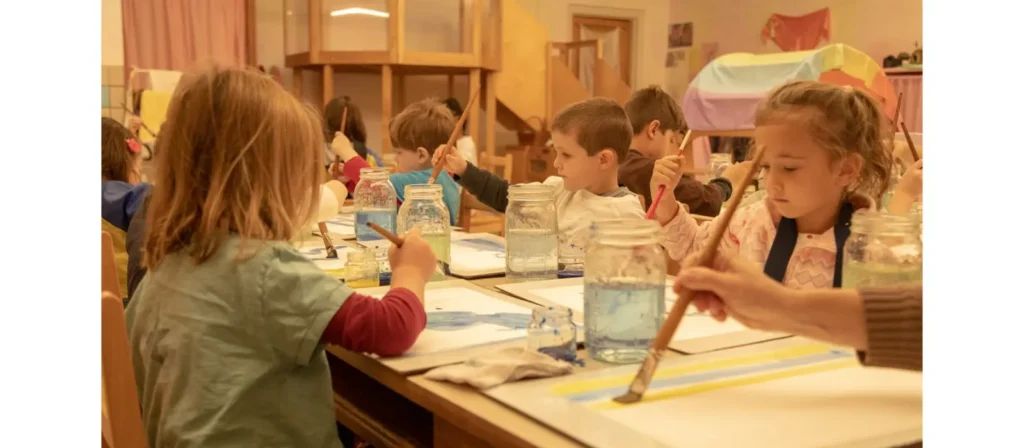
The Foundations of Waldorf Education: Stages of Development
At the heart of Waldorf education is the belief that learning should align with the natural developmental stages of childhood. Rudolf Steiner, the founder of Waldorf education, divided child development into three distinct seven-year phases, each with its own cognitive, emotional, and physical characteristics. The curriculum, teaching methods, and classroom environment are all designed to meet the evolving needs of children in each stage.
1. Birth to Age 7: Develop the Limbs Through Doing
In the first seven years of life, children learn primarily through physical activity, sensory exploration, and imitation. The Waldorf early childhood curriculum reflects this by focusing on play, rhythm, movement, and practical life tasks. Formal academics are intentionally delayed during this period. Instead, children engage in activities such as free play, storytelling, singing, handcrafts, and outdoor exploration, all of which support physical development, imagination, and social skills.
2. Ages 7 to 14: Develop the Heart Through Imagination
The second phase of development is marked by the emergence of emotional sensitivity and the capacity for imaginative thinking. At this stage, Waldorf education introduces more structured academic content—but always through artistic and experiential methods. Subjects like math, science, and language are taught through storytelling, painting, music, drama, and movement. Teachers often stay with the same class for multiple years to provide continuity and emotional security. This period nurtures moral development, empathy, and a deeper connection with the world.
3. Ages 14 to 21: Learning Through Thinking and Individual Judgment
The third developmental stage focuses on critical thinking, abstract reasoning, and the formation of independent judgment. In Waldorf high schools, students engage in rigorous academic studies, project-based learning, philosophical inquiry, and real-world experiences. Adolescents are encouraged to ask deep questions, form their own views, and take responsibility for their learning. The curriculum also continues to integrate the arts, helping students develop both analytical and creative capacities.
Principles of Waldorf Education
The philosophy behind Waldorf education is built on a series of foundational principles that shape its unique and holistic approach to teaching and learning. These principles serve as the core pillars of Waldorf pedagogy, influencing everything from curriculum design to ambiente del aula and teacher-student relationships.
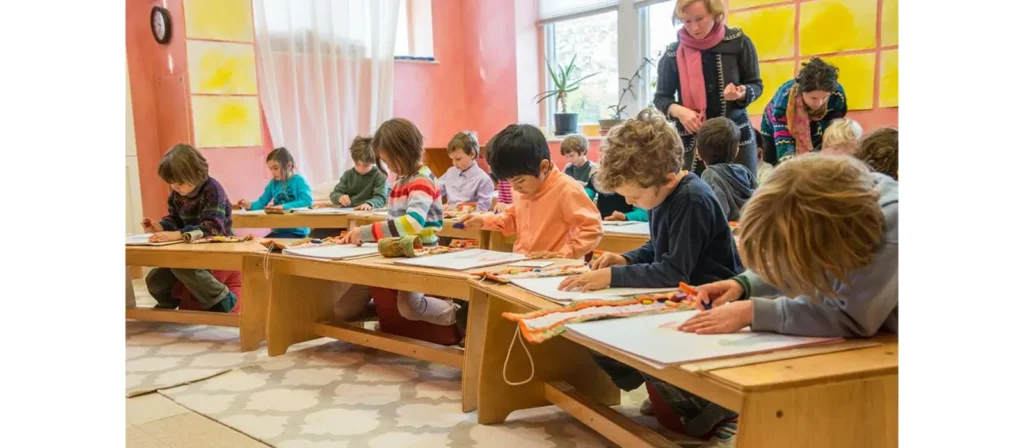
Education of the Whole Child
One of the most essential principles of Waldorf education is its focus on educating the whole child—head, heart, and hands. This means nurturing intellectual growth (thinking), emotional development (feeling), and practical skills (doing) equally. The goal is to raise well-rounded individuals who are thoughtful, compassionate, and capable of meaningful action in the world.
Developmentally Appropriate Learning
Waldorf education is deeply rooted in child development theory, especially Rudolf Steiner’s view of three seven-year stages. Instruction and content are carefully tailored to suit each phase of a child’s emotional and cognitive growth. Learning in early childhood is play-based and sensory-rich, while middle and upper grades focus on imagination, storytelling, and critical thinking, respectively.
Imagination and Creativity at the Core
Another guiding principle of Waldorf education is the cultivation of creativity. Subjects are taught artistically, integrating drawing, drama, music, and movement into everyday lessons. This not only makes learning more engaging but also strengthens neural pathways associated with problem-solving, memory, and emotional intelligence.
Learning Through Experience
Experiential learning lies at the heart of the Waldorf classroom. Instead of rote memorization or passive absorption of facts, students actively engage with their subjects. For example, rather than reading about farming, children in a Waldorf school may grow a garden. This hands-on approach builds a deep, personal connection to the material and encourages lifelong learning.
Consistent Teacher-Student Relationships
Waldorf education emphasizes the importance of long-term teacher-student relationships. In many schools, class teachers remain with the same group of children for multiple years. This continuity fosters trust, emotional security, and a profound understanding of each student’s learning journey.
Minimal Exposure to Technology
During the early years, Waldorf education intentionally minimizes the use of screens and digital technology. This principle is based on the belief that young children benefit most from real-world interactions and sensory experiences. As students grow older, technology is gradually introduced thoughtfully and purposefully.
Rhythm and Repetition
Daily, weekly, and seasonal rhythms are key to Waldorf education. Repetition and routine help children feel secure, allowing them to engage more fully in their learning. Seasonal festivals, storytelling cycles, and rhythmic activities provide structure and reinforce cultural and natural awareness.
Desarrollo moral y ético
Character education is seamlessly woven into the Waldorf education model. Through myths, fables, biographies of historical figures, and classroom culture, children learn about virtues like courage, kindness, honesty, and resilience. The goal is not just to produce knowledgeable students, but compassionate and ethical human beings.
Artistic Integration Across the Curriculum
Art is not a separate subject in Waldorf education—it’s embedded in everything. From illustrating math problems with watercolor to learning grammar through poetry and rhythm, artistic expression is used to deepen understanding and create beauty in learning.
The Central Role of a Waldorf Teacher
In Waldorf education, the teacher is far more than a lesson planner or academic instructor—they are viewed as a guide, an artist, and a moral role model who nurtures the whole development of each child. The relationship between teacher and student lies at the heart of the Waldorf approach, making the educator’s presence, awareness, and inner development as essential as the curriculum itself.
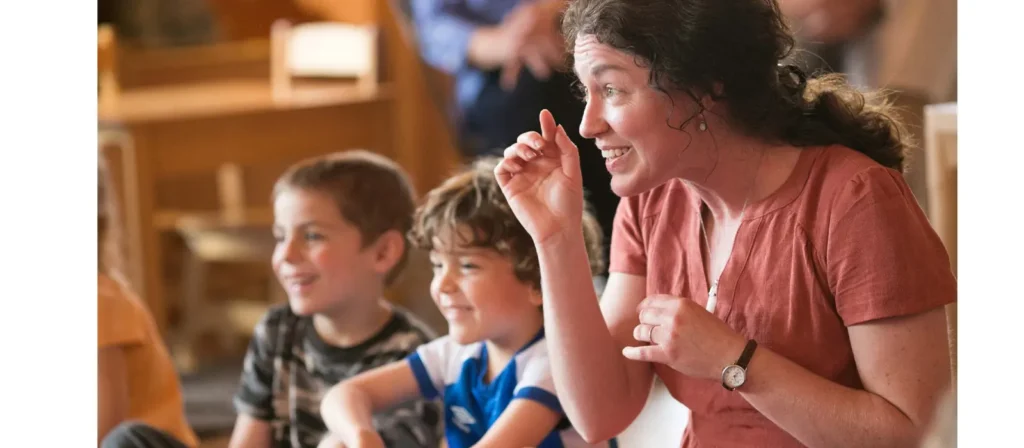
1. A Long-Term Relationship with Students
Unlike in most traditional schools, Waldorf teachers often stay with the same group of students for several years, especially in the primary grades. This continuity allows them to deeply understand each child’s strengths, challenges, and evolving needs. The trust and familiarity that develop over time create a stable and emotionally secure learning environment where children feel seen and supported.
2. Teaching as a Living Art
Waldorf teachers are expected to bring lessons to life through storytelling, movement, music, drawing, and other artistic elements. They are not simply delivering information—they are crafting experiences that speak to the head, heart, and hands. This artistic approach transforms even academic subjects into meaningful and memorable journeys.
3. Observation Over Assessment
Rather than relying on standardized tests, Waldorf teachers observe children closely and document their growth through narrative assessments. These observations inform how lessons are adapted to meet individual developmental stages and support each child’s learning rhythm. The emphasis is on personal progress rather than performance metrics.
4. Inner Development and Self-Education
Waldorf education places high value on the teacher’s own inner work. Teachers are encouraged to cultivate mindfulness, moral clarity, and artistic sensitivity in themselves. This personal development enhances their ability to model balance, presence, and purpose in the classroom—qualities that deeply influence the children they teach.
5. Responsibility for Curriculum Design
While Waldorf schools follow a shared philosophy, teachers have significant freedom in shaping the content and style of their lessons. They adapt the curriculum to their students’ developmental stages, cultural context, and seasonal themes. This flexibility allows for a rich, responsive learning experience, but also requires a high level of dedication, creativity, and preparation.
How Waldorf Education Differs from Other Educational Methods?
Each of these methods offers a distinctive framework and set of priorities. While Montessori emphasizes independence and sensory-based learning, Reggio Emilia focuses on child-led, project-based exploration. Traditional education, by contrast, often leans heavily on academic benchmarks, testing, and standardized curricula. The following tables highlight key differences in philosophy, classroom structure, teaching roles, and developmental priorities—helping parents and educators assess how Waldorf education aligns with their goals and values.
Waldorf vs. Montessori Education
| Característica | Educación Waldorf | Educación Montessori |
|---|---|---|
| Estilo de aprendizaje | Teacher-led, imaginative, artistic integration | Child-led, independent, practical life-focused |
| Ambiente | Warm, natural, home-like | Ordered, minimalist, tool-rich |
| Play Approach | Emphasis on free, creative play | Structured work with purposeful materials |
| Teacher Role | Long-term guide and storyteller | Observer and facilitator |
| Academic Start | Delayed academics, emphasis on readiness | Early academic introduction through materials |
Waldorf vs. Reggio Emilia Education
| Característica | Educación Waldorf | Reggio Emilia Education |
|---|---|---|
| Curriculum Design | Pre-planned by teacher, based on child stages | Emergent, project-based from child interests |
| Art Integration | Central to all learning, teacher-led | Children express learning through many art forms |
| Teacher Role | Guide, artist, moral model | Co-learner, collaborator, documentarian |
| Environment Use | Calm, seasonal, sensory-rich | Dynamic and evolving, part of the learning process |
| Parental Role | Supportive, community-oriented | Active collaborators in learning |
Waldorf vs. Traditional Education
| Característica | Educación Waldorf | Educación tradicional |
|---|---|---|
| Plan de estudios | Artistic, developmental, holistic | Textbook-based, standardized, test-focused |
| Evaluación | Observational, narrative evaluations | Grades, tests, performance metrics |
| Use of Technology | Avoided in early years | Integrated early and widely |
| Configuración del aula | Natural materials, play areas, aesthetic focus | Desks, chalkboards, visual stimuli |
| Emotional Learning | Embedded in storytelling and rhythm | Often informal or absent |
Waldorf-Inspired Classroom Environments
The physical environment in a Waldorf education setting is considered the “third teacher”—an extension of the pedagogy itself. In early childhood classrooms, every detail is purposefully designed to support the developmental needs of the young child, nurturing the senses, sparking the imagination, and providing a sense of warmth, order, and calm.
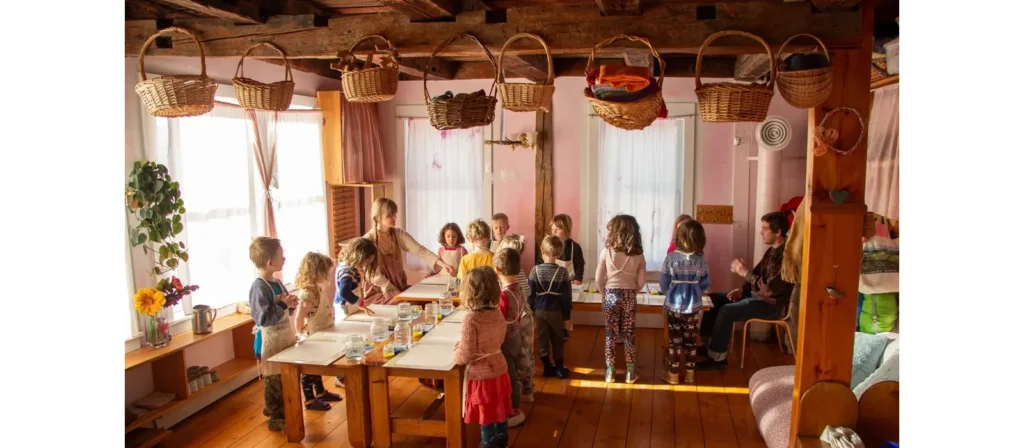
A Home-Like Atmosphere
Waldorf early childhood classrooms are intentionally crafted to feel more like a home than a traditional classroom. Warm wooden furniture, soft lighting, hand-dyed curtains, and natural materials create a cozy and welcoming environment. This design philosophy supports young children’s emotional security and encourages gentle transitions into the school experience.
The absence of plastic and synthetic materials is a hallmark of Waldorf education. Instead, you’ll find wool, silk, cotton, and wood throughout the room—textures that engage the senses and support healthy tactile development. Classrooms often include a small kitchen area for baking bread or preparing snacks, reflecting the integration of practical life skills into daily rhythms.
Nature as a Central Element
In Waldorf education, nature is not only a subject of study but a daily companion. Classrooms are decorated with seasonal displays, nature tables, and found objects like pinecones, stones, shells, and leaves. These elements are part of the rhythm of the year and help children connect with the cycles of nature.
Outdoor play is an essential part of the day, regardless of the weather. Early childhood Waldorf programs typically include long periods of outdoor time in gardens, forests, or natural playgrounds—spaces where children build physical strength, coordination, and a deep appreciation for the environment.
Open-Ended Toys and Materials

Rather than flashy or fixed-purpose toys, Waldorf education promotes the use of open-ended toys and materials that invite imagination. Baskets of cloths, wooden blocks, tree branches, dolls made of natural fibers, and silk scarves become castles, dragons, or family homes—whatever the child envisions in that moment.
This approach not only fosters creativity but also supports social interaction, problem-solving, and emotional development. Toys are intentionally simple so that the imagination can do the rest.
Envíenos un mensaje si tiene alguna pregunta o solicite un presupuesto. Nuestros expertos le darán una respuesta en 48 horas y le ayudarán a seleccionar el producto adecuado que desee.
Order, Rhythm, and Aesthetic Harmony
The layout of a Waldorf early childhood classroom is deliberately ordered and rhythmical. Shelves are low and accessible, spaces are uncluttered, and areas are clearly defined—perhaps one corner for storytelling, another for art, and another for building or quiet time. This sense of order mirrors the daily rhythms and rituals that are central to Waldorf education, helping children feel secure and grounded.
Soft pastel colors on the walls, gentle lighting, and minimal visual noise all contribute to a peaceful environment that supports concentration and emotional regulation. Even the arrangement of chairs in a circle for storytelling or singing fosters a sense of community and togetherness.
Incorporating the Waldorf Education into Your Preschool Program
Introducing Waldorf education into your preschool program doesn’t require a complete overhaul or adherence to every traditional practice. Instead, it’s about weaving core Waldorf principles into your daily rhythms, classroom environment, and teaching philosophy in a way that honors the developmental needs of young children. Whether you are a preschool director, teacher, or homeschool parent, you can start small and build a nurturing, creative, and grounded learning space inspired by Waldorf ideals.
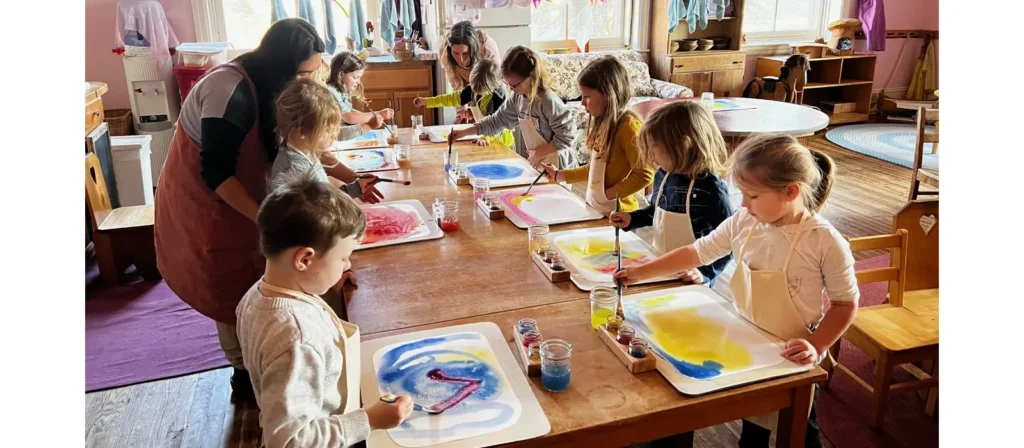
Begin with Rhythm and Routine
One of the easiest and most impactful ways to incorporate Waldorf education is by establishing a predictable daily rhythm. Young children thrive on routine—it provides security and a sense of order. Create a consistent flow to the day with set times for arrival, free play, circle time, snack, outdoor exploration, storytime, and closing activities. Use songs, verses, and seasonal rituals to mark transitions between activities, which helps children feel grounded and engaged.
Weekly and seasonal rhythms can also bring depth to your program. For example, assign a specific activity to each day of the week—like painting on Mondays, baking on Tuesdays, or gardening on Fridays. Celebrate seasonal festivals, nature walks, and changes in the environment to connect children with the rhythms of the earth.
Transform the Environment
In a Waldorf-inspired preschool, the classroom becomes a peaceful, natural sanctuary. Replace bright colors and plastic toys with warm tones and materials like wood, wool, cotton, and silk. Create defined spaces for different activities: a cozy reading nook, an open area for movement and singing, a play kitchen stocked with natural play foods, and baskets of open-ended toys like cloths, blocks, and felt animals.
Natural lighting, handmade decorations, and seasonal nature tables invite children to observe and appreciate beauty. The environment should be simple, uncluttered, and calming—designed to nourish the senses and inspire creativity.
Embrace Play-Based and Imaginative Learning
Waldorf education places a strong emphasis on imaginative, child-led play, especially in the preschool years. Limit direct instruction and focus instead on providing open-ended materials and time for unstructured play. Through pretend play, children develop social skills, language, empathy, and problem-solving abilities.
Incorporate storytelling, puppet shows, and nature-based crafts to support creativity and connection. Let learning emerge naturally from daily experiences—helping prepare a snack, folding laundry, watering plants, or building a fort all become meaningful learning opportunities in a Waldorf preschool.
Slow Down
One of the core tenets of Waldorf education is protecting childhood from overstimulation. Avoid screen time and fast-paced media. Instead, encourage quiet, focused activities like drawing, finger knitting, watercolor painting, and storytelling. This slower pace gives children time to process, wonder, and imagine without external distractions.
Cultivate Teacher Presence and Mindfulness
Incorporating Waldorf education also means embodying the qualities of a calm, centered, and intentional teacher. Children learn as much from who you are as from what you do. Move slowly and purposefully, speak with gentleness, and engage in meaningful, mindful tasks. Model wonder, gratitude, patience, and joy in everyday activities.
Your presence becomes the emotional foundation of the classroom, guiding children not just with words but through energy, rhythm, and example.
Start Small, Grow Naturally
You don’t need to adopt every aspect of Waldorf education all at once. Start with a few elements—perhaps creating a seasonal nature table, incorporating daily rhythms, or telling a story with handmade puppets—and build from there. Over time, these practices will deepen the connection, joy, and harmony in your preschool environment.
Preguntas frecuentes
- Why does Waldorf education delay reading and writing?
Waldorf educators believe academic skills should align with developmental readiness. Reading and writing are usually introduced around age 7, when children are better prepared to engage with abstract thinking. - What is Waldorf education, and how does it differ from traditional schooling?
Waldorf education is a holistic, arts-integrated teaching philosophy that emphasizes developmental stages, creativity, and hands-on learning. Unlike traditional schools, it delays formal academics and discourages early screen use. - At what age should children start Waldorf Education?
Waldorf Education typically begins with early childhood programs around age 3 to 6, emphasizing play-based learning. Formal academics are introduced gradually after age 7, following the child’s developmental readiness. - What role do teachers play in Waldorf Education?
Waldorf teachers are deeply involved in students’ developmental journey. Often, a class teacher stays with the same group of students for multiple years, fostering strong relationships and a deeper understanding of each child. - Are Waldorf students prepared for college and modern careers?
Yes. Waldorf graduates are known for their creativity, adaptability, and critical thinking. Many pursue higher education and succeed in various fields, from the arts to sciences and business. - How can parents incorporate Waldorf principles at home?
Parents can support Waldorf values by encouraging creative play, establishing daily rhythms, limiting screen time, involving children in household tasks, and offering natural materials and open-ended toys.
Conclusión
Waldorf education offers a deeply human-centered approach to early childhood learning—one that honors the rhythm of child development, nurtures creativity, and fosters a lifelong love of learning. Rooted in Rudolf Steiner’s philosophy, it emphasizes the education of the whole child: thinking, feeling, and doing. Through imaginative play, storytelling, artistic expression, and strong teacher-student relationships, Waldorf classrooms become places where wonder is cultivated and every child is seen as a unique individual.
While it may differ sharply from conventional academic models, the strengths of Waldorf education lie in its intentional pacing, its emphasis on joy and meaning, and its respect for childhood as a sacred stage of life. Whether you’re an educator seeking to enrich your teaching practice or a parent searching for an educational philosophy that aligns with your values, Waldorf offers a compelling, time-tested alternative.
As more families and schools recognize the limitations of traditional metrics-driven learning, Waldorf education continues to inspire a global movement that prioritizes depth over speed, connection over content, and purpose over performance. It’s more than a method—it’s a mindset that reminds us what education can truly be when it is rooted in beauty, rhythm, and the unfolding wisdom of childhood.

